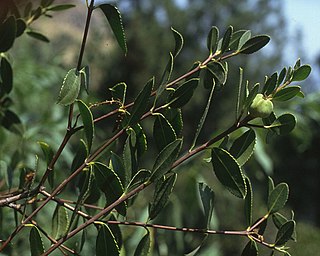
Colliguaja is a plant genus of the family Euphorbiaceae first described as a genus in 1782. It is native to South America.
- Colliguaja brasillensisKlotzsch ex Baill. - Paraguay, S Brazil, Uruguay
- Colliguaja dombeyanaA.Juss. - S Chile
- Colliguaja integerrimaGillies & Hook. - S Chile, W Argentina
- Colliguaja odoriferaMolina - N & C Chile
- Colliguaja salicifoliaGillies & Hook. - C Chile
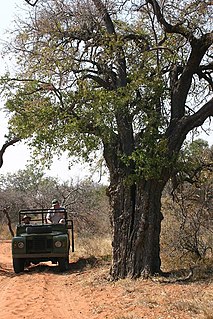
Spirostachys is a plant genus of the family Euphorbiaceae first described as a genus in 1850. It is native to Africa. Zuloaga, F. O., O. Morrone, M. J. Belgrano, C. Marticorena & E. Marchesi. (eds.) 2008. Catálogo de las plantas vasculares del Cono Sur. Monographs in systematic botany from the Missouri Botanical Garden 107(1–3): i–xcvi, 1–3348.
Parodiodendron is a monotypic plant genus under the family Picrodendraceae, described as a genus in 1969. The sole species is Parodiodendron marginivillosum(Speg.) Hunz..
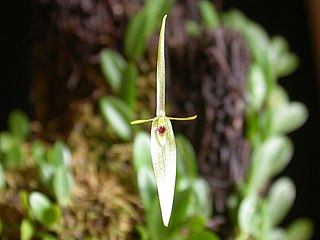
Barbosella cogniauxiana is a species of orchid.
Neonothopanus nambi is a poisonous and bioluminescent mushroom in the family Marasmiaceae. The genetic and molecular mechanisms underlying this species' bioluminescence were published in 2019, the first to be elucidated for a fungus. In 2020, genes from this fungus were used to create bioluminescent tobacco plants.

Ortachne is a genus of Latin American plants in the grass family.

Echinopsis chamaecereus is a species of cactus from Argentina. Synonyms include Chamaecereus silvestrii and Lobivia silvestrii. It has been called the "peanut cactus", This plant should not be confused with Echinopsis silvestrii, another species with a very different appearance.

Carlo Luigi Spegazzini, in Spanish Carlos Luis Spegazzini, was an Italian-born Argentinian botanist and mycologist.
Aspidosperma quebracho-blanco 'Pendula', or weeping white quebracho, is a weeping tree and a cultivar of Aspidosperma quebracho-blanco, the White Quebracho. It was first described by Spegazzini from Santiago del Estero, Argentina in 1910. No trees are known to survive of this cultivar.

Araucaria mirabilis is an extinct species of coniferous tree from Patagonia, Argentina. It belongs to the genus Araucaria.
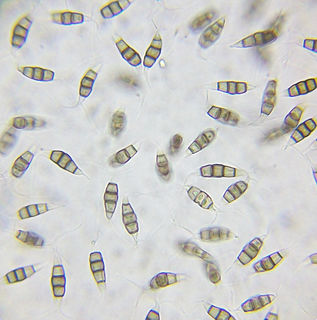
Pestalotiopsis microspora is a species of endophytic fungus capable of breaking down and digesting polyurethane. Originally identified in 1880 in fallen foliage of common ivy in Buenos Aires, it also causes leaf spot in Hypericum 'Hidcote' shrubs in Japan.
Schickendantziella is a plant genus in the Amaryllidaceae. It has only one species, Schickendantziella trichosepala, native to Argentina and Bolivia.

The Nassauvieae are a tribe of flowering plants in the family Asteraceae.
Lentinula guarapiensis is a species of agaric fungus in the family Marasmiaceae that is found in Paraguay. Originally described by Carlos Luigi Spegazzini in 1883 as Agaricus guarapiensis, it was moved to the genus Lentinula by David Pegler in 1983. It is only known from the type collection.

Benthamiella is a genus of plants in the family Solanaceae, native to Patagonia in southern South America. Its species have been described as "attractive, small, cushion plants".
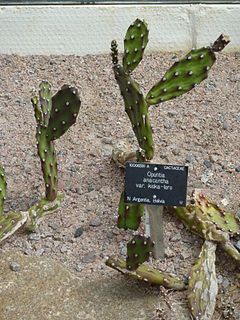
Opuntia anacantha is a species belonging to the family Cactaceae, native to northern Argentina and Bolivia.
Chilocardamum is a small genus of four herbaceous cress-like species of plants in the family Brassicaceae, only found growing in Patagonia, southern Argentina.
Amerosporium is a genus of fungi belonging to the family Sclerotiniaceae.
Xenonectriella subimperspicua is a species of lichenicolous fungus in the family Nectriaceae. It has been recorded from South America, Europe, and New Zealand.
Philippiella is a monotypic genus of flowering plants belonging to the family Thymelaeaceae. It just contains one species, Philippiella patagonicaSpeg.










